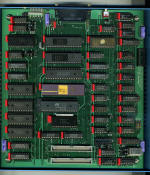
The Huntsville Microsystems 6809E Emulator
Another legacy debugger from eBay. There's about nothing known abut this device, which dates from around 1984 and is intended to be used as a serial port debugger. Mine came without anything. I had to put together a PSU for it. I also found that the 68B09 was defective. Once that was fixed, it worked. The device is an SBE-09, and I have serial number 1128. Mine dates from somewhere in the second half of 1984.
Huntsville Microsystems was an active developer of sophisticated debugging technology in to the early 2000s. They were purchased in 1998 by Avocet systems, a software company with development tools for a wide range of processors. Between the tech collapse and the shift to processors with embedded debug capability, Huntsville Microsystems seems to have shut down around 2004. The company's web site can be found on archive.org, but there's nothing there for something this old. Avocet is still around.
The device uses a regular 25-pin serial port, and has an autosense baud rate - hit enter to win. A ? makes it display its commands. It has a control processor that gives it limited capabilities without the 6809 in a target. The device has breakpoints, but no trace capabilities.
The ROM image. It is a 27128, and looks like it is 8085 code.
Here are the innards. I have removed the probe, which is just some ribbon cable and a header. I also pulled a couple of tall jumper packages from the empty sockets to get a better image. Everything is socketed.
The power pins are, looking at the connector from the outside, left to right, -12; gnd; +12; gnd; +5V. The 12s are there for the RS232.
Interesting Parts
SY2130-3, Syntertek 1024x8 dual-port RAM - presumably, the control processor
sticks emulation code in here.
Intel 8085 microprocessor and infrastructure for all the serial and control
stuff
4 8kx8 SRAMs, for a total of 32k of emulation memory. This is mapped by the
user.
The jumpers in the top left are for the serial port. I suspect that the jumpers
in the bottom right have something to do with the 6809/6809E configuration.
Here are the available instructions.
+Axx
+Start in-line assembly at address xx
-BAxx -Set emulator
memory start address to xx
+BP
+Display breakpoint conditions
-BPC -Change
breakpoint conditions
+Cxx,yy,zz +Compare memory blocks
-Dxx,yy -Display memory
block--addresses optional
+DH
+Disable handshake mode
-DT
-Disable target system
+EH
+Enable handshake mode
-ET
-Enable target system
+Fxx,yy,z +Fill memory block with z
-G
-Start program execution from current location
+G,xx +Start program
execution and break at xx
-Gxx -Start
program execution from xx
+Gxx,yy +Start program execution
at xx and break at yy
-H
-Display current hex format
+HC
+Change hex format
-I
-Enter hex filename ---if linking software used
+Lxx,yy +Disassemble
memory---addresses optional
-Mxx,yy,zz -Move a block of memory
+MM
+Display memory map
-MMA
-Complement memory map status
+MMC +Change
memory map
-MTxx,yy -Run memory test
+MTLxx,yy +Run long memory test
-Rxx -Read hex
file with optional bias
+RS
+Reset target system
-Sxx - -Substitute memory
+SNxx +Substitute
memory with no address increment
-SP - -Stop program
execution
+SSx
+Single-step---number of steps optional
-SSX - -Single-step
continually
+ST
+Give status of 6809
-Wxx,yy -Write memory block in
hex format
+X
+Display registers
-Xr
-Examine/change register r
+XFf
+Examine/change flag f